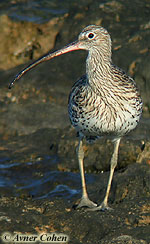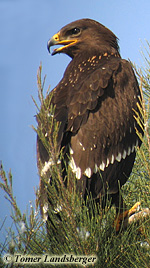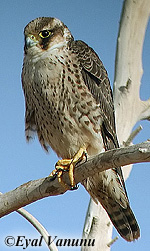| Home |
| Rarities Committee |
| IL400 Club |
| Checklist |
| Monthly Summaries |
| Birding Reports |
| Rarity Alerts |
| Historical Records |
| Articles |
| Gallery |
| Video Clips |
| Contact Us |
>> Historical Rarity Records
Oriental Pratincole (Glareola maldivarum), 2-3/OCT/99 | |||||||||
| Eyal Shochat | |||||||||
|
In the late 1990s, I was operating a bird ringing station in Beer Sheva. In autumn we worked 2-3 times a week, especially on weekends. On Saturday, 2 October 1999, it was one of those classic migration days with birds everywhere throughout the city. I did not want to give that day up, but no other ringer could join me, and since I did not have a car of my own, all the excuses were there to stay at home, sleep in, and catch up with missing sleeping hours from the past two months. Only a lunatic wouldn't take the opportunity. Saturday, 4:30am, I am on a borrowed bike, a big backpack on my back with as much equipment as I could fit in, fighting the thick, dusty bush of tamarisk trees at the Beer Sheva wadi in the dark. By 6:00 a few Willow Warblers, Yellow Wagtails and Short-toed Larks were already shaking the pockets of the long line of nets that crossed the alphalpha field. By 7:30 I already realized that while setting up the nets in the dark, I put the mist nets in the worst part of the field. I took the whole line down and placed it in a better position. By 8:00 it worked out well, with a decent increase in capture rate. And by 9:00 the pratincoles started calling. Maybe it was a good thing that Ido Tsurim could not join after all... We had that silly game bored twitchers play, called "the year list contest". And by the 2nd of October we still missed Black-winged Pratincole. And it was a perfect date for them, and Ido could not join, and now I was about to go grip him off. Could it get any better than that? The flock was circling in the air catching bugs over the far side of the field. The nets were visited recently and almost clean of birds, it was not too hot yet, and not too far to go for 2-3 minutes, tick a BWP, and return to check the nets. I took a walk 300 m westwards, got to the point where the flock that was now very high in the clear sky was straight overhead, looked through the binoculars and picked out one pratincole. Bingo! A beautiful BWP. I could easily tell - it had no white trailing edge to the wing. With the too easy, successful twitch, I was now supposed to go back, but something must have made me stay and watch the bird. It may have been one of those cases where the eye catches something but the information does not continue for further processing in one's brain. Possibly a minute or two passed before the skeptic guy in me started questioning the whole deal. It may have been the short tail that made the bird look like a young Barn Swallow, compared with the rest of the flock that looked more like adult swallows. Having to go back to the nets I could live with that, but the skeptic in me would not give up easily. And now he asked the question about what I must have seen but refused to notice for all that time: if this is a "beautiful Black-winged Pratincole", how come the underwing is red? What do you say to that? A little shudder passes through your nape, your thoughts wander back seven years, to a late autumn day in a stinking swamp in Southern Thailand. Things start to fall into place. With my year list having increased by two species, I rushed to the nets, released all birds without ringing (the first time in my life), took the nets down, packed the gear in the backpack, jumped on the bike and cycled back home (by now it was bloody hot). I called Ido saying that whatever it is he is doing, he might want to grab his bins, scope and camera, and come pick me up ASAP. Around noon we were back in the sewage ponds, 300 m north of the field. Pratincoles are tame birds, and now a flock of 12 birds sat on the bank very close to the car. We checked them one by one, searching for one with a short tail. It took some time because some of them sat low on the black sediment between the bank and the water, at difficult viewing angles. We wondered about one or two of them. But when we reached the last bird there was no doubt about the shortness of its tail. We had an adult Oriental Pratincole nailed. The bird, with the rest of the flock (8 Collared and 3 Black-winged) kept making short flights (5-10 m) each time we approached, giving good views of the under wing pattern. It was red, with no sign of white on the trailing edge. All pictures ever taken of this bird were taken during that time. Owing to the time of the day (around 12:00-13:00) light condition was challenging. My pictures were a bit under-exposed, and Ido had them slightly over-exposed. For such a bird we could not complain. By the afternoon several twitchers made their way down to the area to look for the 1st and only "first to Israel" ever found in Beer Sheva (by then it was considered as second, but the 'first' was withdrawn later on and was never submitted to the IRDC). Some managed to see it, but the flock behaviour in the afternoon was much more difficult then earlier in the day and the afternoon winds did not help either. Those who failed to find the flock on the ground or get close views returned on the next morning and had a successful twitch. The flock remained in the area until 5 October, probably including the OP, but there was no confirmed observation after 3 October, maybe because most searches were done in the afternoon. By mid 2007 it remains the only Israeli record of Oriental Pratincole.
| |||||||||
| |||||||||
 Curlew (Numenius arquata) Acre shore, Sep.05 |
 Lesser Spotted Eagle (Aquila pomarina) Bet Shean valley, Oct.05 |
 Barbary Falcon (Falco pelegrinoides) Yotvata, Oct.05 |
Back to top
